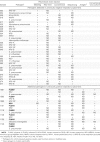MassTag polymerase-chain-reaction detection of respiratory pathogens, including a new rhinovirus genotype, that caused influenza-like illness in New York State during 2004-2005
- PMID: 17054069
- PMCID: PMC7110122
- DOI: 10.1086/508551
MassTag polymerase-chain-reaction detection of respiratory pathogens, including a new rhinovirus genotype, that caused influenza-like illness in New York State during 2004-2005
Abstract
In New York State during winter 2004, there was a high incidence of influenza-like illness that tested negative both for influenza virus, by molecular methods, and for other respiratory viruses, by virus culture. Concern that a novel pathogen might be implicated led us to implement a new multiplex diagnostic tool. MassTag polymerase chain reaction resolved 26 of 79 previously negative samples, revealing the presence of rhinoviruses in a large proportion of samples, half of which belonged to a previously uncharacterized genetic clade. In some instances, knowledge of the detected viral and/or bacterial (co)infection could have altered clinical management.
Figures


References
-
- Fan J, Henrickson KJ, Savatski LL. Rapid simultaneous diagnosis of infections with respiratory syncytial viruses A and B, influenza viruses A and B, and human parainfluenza virus types 1, 2, and 3 by multiplex quantitative reverse transcription-polymerase chain reaction-enzyme hybridization (Hexaplex) Clin Infect Dis. 1998;26:1397–402. - PubMed
-
- Templeton KE, Scheltinga SA, Beersma MFC, Kroes ACM, Claas ECJ. Rapid and sensitive method using multiplex real-time PCR for diagnosis of infections by influenza A and influenza B viruses, respiratory syncytial viruses, and parainfluenzaviruses 1, 2, 3, and 4. J Clin Microbiol. 2004;42:1564–9. - PMC - PubMed
-
- Khanna M, Fan J, Pehler-Harrington K, et al. The Pneumoplex assays, a multiplex PCR-enzyme hybridization assay that allows simultaneous detection of five organisms, Mycoplasma pneumoniae, Chlamydia (Chlamydophila) pneumoniae, Legionella pneumophila, Legionella micdadei and Bordetella pertussis and its real-time counterpart. J Clin Microbiol. 2005;43:565–71. - PMC - PubMed
Publication types
MeSH terms
Substances
Associated data
- Actions
- Actions
- Actions
- Actions
- Actions
- Actions
- Actions
- Actions
- Actions
- Actions
- Actions
- Actions
- Actions
Grants and funding
LinkOut - more resources
Full Text Sources
Other Literature Sources

